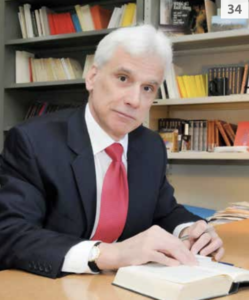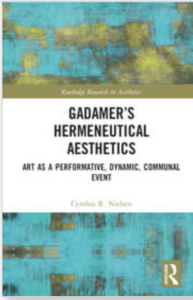 Interview with Jean Grondin
Interview with Jean Grondin
*Abdullah Başaran and Kadir Filiz
* Can we still think of hermeneutics as the ground of philosophy? That is to say, is it still possible to consider language as a center and medium of philosophy? If we want to revisit the task(s) of hermeneutics, what do we expect to see?
JG: “First of all, I would like to thank you most warmly for this conversation and the opportunity to discuss with you. Philosophy has always been a dialogue and I cherish the opportunity to have this conversation with you.
I don’t know if hermeneutics has to be the ground of philosophy – both Plato and Aristotle said that the ground of philosophy was wonderment, and I would certainly agree with them –, but it is the way philosophy is carried out: we are self-interpreting beings (Charles Taylor), we strive to understand and thus interpret. And this interpretation, more often than not, happens through language. As such philosophy has always and will always be hermeneutical, regardless if the word hermeneutics is used or not.”
* After the linguistic-turn of hermeneutical philosophers (Heidegger, Gadamer, Ricoeur), and with the emergence of realist movements and the dominance of natural sciences in philosophy, today it is commonly assumed that hermeneutics has lost its impact on thinking. Is hermeneutics (regarding its dialogical history with critical theory, deconstruction, and various philosophies of language) still in competition with today’s philosophical tendencies?
JG: “First of all, I would say that hermeneutics is not against realism: it strives to understand the meaning, the meanings, of things, and can learn a lot from the natural sciences (it only believes that their objectifying mode of knowledge, precious as it is, is not the only one and probably not the most important one for philosophy and self-understanding).
Secondly, I don’t view hermeneutics as being in competition with other philosophical tendencies. Philosophy is not a market where one company has to crush another or increase its market share. Thankfully, there have always been different philosophical voices and we can all learn from another. As you know, my teacher Hans-Georg Gadamer used to say that the soul of hermeneutics is that the other might be right.
I am not sure hermeneutics has lost its impact on thinking. The three philosophical authors you name, Heidegger, Gadamer, Ricoeur, are still widely read and have many descendants. My compatriot Charles Taylor is certainly one of them and he has recently published a book on The Language Animal which defends a view of language that one has to characterize as hermeneutical.”
* From the centrality of hermeneutics in any philosophical thinking, we want to ask about your idea of hermeneutics as metaphysics or the renewal of hermeneutics as metaphysics if one may say so. This issue has many dimensions when we consider many (mis)labellings identified with hermeneutics such as “relativity”, “historicity”, “anti-rationality”, and so on. First, may we shortly ask, “what is called metaphysics?” among many forms of metaphysics throughout the history of philosophy (as you discuss in your book from Parmenides to Levinas), how can we give a unitary determination to metaphysics in the light of hermeneutics? Does what you mean by metaphysics consist of former conceptions of metaphysics?
JG: “What is metaphysics? It is the dialogical, vigilant and self-critical effort of the human mind to grasp something about reality as a whole (or Being, if you prefer) and its many orders of reason. This conception of metaphysics, which one can call hermeneutical, certainly draws on former conceptions of metaphysics, since all metaphysicians were animated by this striving to understand something about reality as a whole. Their answers are not the same (metaphysics is not mathematics), and this is why a reflective metaphysics has to be dialogical and self-critical: we have to think Plato with Aristotle, Kant with Hegel. We are the heirs of this dialogue that preceded us and will survive us.”
* Second, hermeneutics is also regarded as a way to overcome metaphysics and aims to do a non-metaphysical way of philosophy by some philosophers. We can also find this tendency of overcoming metaphysics in Gadamer (but also some metaphysical theses too, as you show in your work). In this regard, how do you understand this overcoming aspect of hermeneutics together with its metaphysical commitments? Where does the hermeneutical idea of overcoming metaphysics stand in your understanding of metaphysics?
JG: “I, for one, would stress more the metaphysical dimension of hermeneutics, but I know I might be a lost sheep in this regard. The stronger, even faddish tendency today is indeed to do away with metaphysics, but I cannot fail to notice that those ‘overcomers’ often have scant knowledge of the metaphysics they want to leave behind. What authors such as Heidegger, and to a lesser degree Gadamer, want to overcome, is perhaps a certain conception of metaphysics that would have led to the domination of calculative rationality. As Gadamer has suggested, this is by no means the only, nor the natural outcome of metaphysics.”
* Third, metaphysics presupposes a universality of reason, and you put forward the universality claim of hermeneutics in this direction. On the one hand, hermeneutics has taught us that there is not one way of rationality, and on the other hand, metaphysics must pose some basic rules that are always at work in every place and time in order to understand reality. How do these two different ways of understanding reality (multiple rationalities and the universality claims of metaphysics) reconcile and stand without contradiction?
JG: “There have always been many orders of rationality. Aristotele famously distinguishes four different types of causality. For me (and for Gadamer), it would be irrational to think there is only one way of rationality. That would be the epitome of irrationality.”
* In addition to the last point, during the discussions over the postmodern perspectives to interpretation, you strictly rejected relativism in hermeneutical point of view on the grounds that relativism only makes sense if it adopts an absolutist point of view. Simply put, does not metaphysics propose another absolutism?
JG: “Good question. I only reject relativism if this is supposed to mean that there is no attainable truth. Yet, there is such a thing as a ‘healthy relativism,’ as it were, which I would not disregard: it is the notion, to put it almost tautologically, that every point of view is indeed relative to a certain point of view. This healthy relativism is a school of humility: we must and can strive to overcome the limited scope of our points of view and learn from others. We are never condemned to our perspective(s), we can go beyond its limitations. This is not an absolutism.”
* In the same way, hermeneutics focuses on our historical condition and the historicity of thinking. For example, Vattimo’s work pays attention to this radical side of hermeneutics. Moreover, as you point out in your book, metaphysics was only a type of philosophy before Heidegger, and after him it’s the history of metaphysics we started to speak. Can metaphysics be understood as something historical? How can a philosophical work transcend its historical determinations? As Habermas asked, “after historicism, is metaphysics still possible?”
JG: “Metaphysics is certainly a historical endeavour in that it unfolded in the course of history. I have tried to sketch out that history in my Introduction to Metaphysics. Heidegger even argued that it was our “destiny” and has been constitutive of the Western tradition. In this, he is not wrong. I would only argue against him that there is no credible alternative to metaphysics and that any thinking that would want to go beyond metaphysics would still be indebted to its type of reflection on the whole and its reasons.
As for the question, ‘after historicism, is metaphysics still possible?,’ I would say that metaphysics has always been possible because it is an integral part of humanity’s conversation with itself about the meaning of things. Historicism only makes this dialogical quest more indispensable and thus ‘more possible.’”
* Together with historicity, another aspect of understanding and thinking can be its locality or in a sense, its particularity. In your books on metaphysics, you refer to “Western” metaphysics and philosophers. It is the Western history of metaphysics (Such an expression can also be found in Heidegger and many other philosophers). Without establishing a hegemony of a particular place over other places, without appealing to an assumption of the centrality of any particular history and tradition, how can we speak of metaphysics? Between the idea of the relativity of traditions and the dominant universality of a single one, is it possible to consider any other way of thinking which does not suppose the hegemony of a particular tradition (history and place) over others?
JG: “Here I can only thank you for pointing out my own limitations, and I honestly mean that. I have only spoken about the Western history of metaphysics because it is the only one I am familiar with. It is certainly not the only one. But I cannot speak with any authority of other traditions. Unfortunately, but I can sure learn from them. It is one of the important metaphysical insights of our time that the Western tradition is not the only way of philosophy and metaphysics.”
* In this line, for example, in the monumental work, Provincializing Europe, Dipesh Chakrabarty starts with a quotation from Gadamer who uses (probably firstly) the expression of “provincializing Europe”. Gadamer’s hermeneutics made an important contribution to overcoming Eurocentrism in social sciences. Can the idea of hermeneutics as metaphysics offer such an openness to go beyond any kind of domination of a particular historical determination of philosophy?
JG: “It is certainly open to this possibility and quite aware of the limitations of the European point of view. I don’t know however if one has to call this a ‘provincializing’ of Europe, for at least two reasons: Firstly, it is right to point out that European thinking has indeed been dominant in the history of the last two millennia, so it would be difficult to ‘provincialize’ it all of a sudden (it would be like attempting to provincialize natural science, technology, etc.; good luck with that!) I would rather say that European thinking has to be endowed with a stronger sense of humility and, at times, contrition. Secondly, I would be careful with this provincializing of Europe, because there is much in the European tradition that can be defended and maintained. One can think of its science, its sense for democracy and human rights, its metaphysics, its tradition of education, Law, etc.”
* Regarding your last works on metaphysics, we would like to ask what you mean by ‘sense of things’ (sens des choses)? You state that senses are not creatures of our linguistic and cultural system. Is it in a way a realistic understanding of things that are understandable for us?
JG: “I mean at least two things by this. Firstly, that meaning is not something that is only created by our linguistic and cultural systems. It is a meaning in the things themselves. To give but one example: if I wish to understand as a physician the ailment from which a patient is suffering, I want to understand its real meaning, i.e., what it is the patient is suffering from: is it a cancer, an aneurism, etc.? It would be ridiculous to claim that this is a creation of our linguistic systems (even if the names ‘cancer’ and ‘aneurism’ are words of our language, with a rich history indeed). Secondly, I mean by this ‘sense of things’ that we can sense (in the perceptive sense, if you want) this meaning or sense in the things, and do so all the time. Our inquiring minds and senses strive to sense this meaning of things.
* Hermeneutics is mostly associated with conservatism because of its emphasis on tradition (it is also a bit problematic to translate Überlieferung as “tradition”) and prejudices of understanding. One aspect of the discussion between Gadamer and Habermas stems from this claim. Does hermeneutics offer us a conservative approach to the past rather than a critical one? Moreover, hermeneutics mostly deals with the past, rather than the future in the present. How can we think of our understanding regarding the future?
JG: “This is an old debate of which I must confess that I have grown a little bit tired. As an understanding quest, hermeneutics is not conservative, nor does it promote in any way what could be called a conservative agenda in the field of politics. What does it mean to be conservative in politics? I suppose that a conservative agenda favours things like a limited role for the government, lower taxes, a stronger military and certain views on social issues like gay marriage, abortion, etc. I dare anybody to find a hermeneutical philosophy that takes a specific stand on these issues, which pertain to the political field.
I would also question the notion that an approach is either conservative or critical. Why not both at times? We would certainly all agree that it is critical to conserve our natural environment and many of our best cultural traditions.”
* Can we assume a strict separation between phenomenology (not only the Husserlian starting but also involving the recent French phenomenologists up until now) and hermeneutics? No doubt Husserl and Heidegger are some of the main philosophers Gadamer seriously engaged. Can we see hermeneutics as a part of the phenomenological tradition? Is there any difference between the understanding of the sense of things and “to the things themselves”?
JG: “Hermeneutics obviously belongs the phenomenological tradition. There are however many different ways of doing phenomenology and we can distinguish in this regard the way of Husserl from that of Heidegger, Ricoeur or Gadamer (and many others, of course). This plurality makes phenomenology stronger, I believe. The sense of things is indeed related to Husserl’s injunction to return to the things themselves.”
* As opposed to Heidegger’s negative attitude toward humanism, you argue that Gadamer’s position is quite affirmative in the sense that hermeneutics itself is a ‘human’ endeavor. Without regard to the recent debates on posthumanism or transhumanism, to what extent do we need a humanistic point of view?
JG: “Gadamer’s position is indeed quite affirmative in that he began his major work Truth and Method with a powerful rehabilitation of the main tenets of humanism, most notably the notion that the human being is in need of education (Bildung) and can develop his capacity of judgment, taste and common sense. This capacity can be developed by learning from history, literature, art, philosophy, religion, the dialogue with others, models, and not only through the objectifying mode of knowledge of pure methodological science.
Its view of the human condition also has the virtue of being an incarnated one, one that is rooted in the disquiet of the human heart (Augustine) and can help us resist the sheer unreality of posthumanism or transhumanism, which makes one shudder. We are always on the human side of things.”
* As a follow-up question, although it has distanced itself from the shadow of biblical hermeneutics of the previous centuries, philosophical hermeneutics as a study of ‘human’ understanding and finitude has not withdrawn the question concerning God. What makes the idea of God still important for philosophy? To be more specific, is religious experience related to this side, the human side, of the horizon, or to the beyond? Can we contemplate the possibility of a hermeneutical philosophy of religion?”
JG: “The idea of God has always been paramount for philosophy and the best philosophers (including Marx and Nietzsche) all had a solid religious upbringing. As Kant argued, the notion of God is essential to human reason and human reflection raises this question naturally. All humans also have very strong views on God and religion. Just go out on the street and ask them about their opinions on God and religion and you will confirm this is the case. Indeed, they have more views on this subject than any other philosophical subject. I don’t see how philosophy can move away from such a basic preoccupation of human reason.
There are indeed quite a few hermeneutical philosophies of religion. Authors such as Jean-Luc Marion, Charles Taylor (A Secular Age), Paul Ricoeur, Richard Kearney, Jean Greisch (who wrote a trilogy on the philosophy of religion) come to mind. I have written a modest booklet on the philosophy of religion, where I understood the term as a subjective genitive (i.e., the philosophy that is already integral to religion itself and prepared the way for philosophy). The younger Heidegger (and also the later one) had much to say about the religious experience, as did in his way Gadamer. The last piece Dilthey wrote a few days before his passing was also about religion. And let us not forget about Schleiermacher’s very impactful discourses on religion.”
* Last question for humanism: Gadamer’s later project of “going back to the beginning of philosophy” is another task he employed for hermeneutics. Do you agree with him? Is hermeneutics to be primarily used for reading human classics?
JG: “As a classical philologist and a philosopher it was only natural for Gadamer to reflect on the beginning of philosophy. I recall that the first lecture course of Gadamer I ever followed in Heidelberg, in the summer of 1977, was titled ‘On the Beginning: Heraclitus and Parmenides.’ This lecture course was one of the sources of his later book on the beginning of philosophy. Since philosophy is a discipline that resolutely starts with the beginning, to quote Schelling, it is a most legitimate field of hermeneutical inquiry, yet one that is also clouded in mystery since we have little knowledge of the beginning itself and know much more about what followed this beginning, especially since we have more texts of this later epoch and only fragments about the beginning. Needless to say, hermeneutical inquiry can be applied to many other fields, indeed to all, given the universality of hermeneutical understanding.”
* A few years ago, you published a book on understanding Heidegger and you also took into account his Black Notebooks for his trajectory of thought. Why does Heidegger still matter? How can we understand his Black Notebooks in regard to his corpus and philosophical project?
JG: “Heidegger matters immensely because he is a major philosopher and has much to teach us about the human condition, about language and art, about our history, modernity and modern technology. He matters mostly, I would say, because he identified correctly the nihilistic impasse of our technocentric civilization, which he traced back, correctly or not, to the Greek beginnings of metaphysics, thus enabling us to see the instrumentalism of technological thinking as a consequence of the nominalism of a certain metaphysical thinking. My contention with him would be that he was wrong in believing one had to go beyond metaphysics in order to overcome the nominalism and nihilism of modernity. I relied in this regard on Gadamer’s distance with Heidegger’s unyielding reading of metaphysics and its allegedly constraining language. I thankfully take up Gadamer’s discreet hints about another possible reading of metaphysics.”
* One can argue that hermeneutics arrived late to the philosophical problem(s) of body and corporeality — apart from the theological problems of incarnation. Heidegger (except the Zollikon Seminars) and Gadamer (except his several short works on health), perhaps because of the danger of reductionist materialism at their time, abstained from the phenomenological investigations of embodiment. In fact, as phenomenology has brought it to the fore, philosophical hermeneutics has mostly remained unconcerned. In your opinion, what was the main reason(s) for this lack of interest? We can also reflect upon Ricoeur’s idiosyncratic exemplar.
JG: “If phenomenology only came late to this question, one can only say: better late than never! However, I am not sure that is really true of phenomenology. There are many reflections of Husserl on the body and you refer rightly to Ricoeur and to his early work on Le volontaire et l’involontaire, to say nothing about Merleau-Ponty or Heidegger’s ideas on affectivity (Befindlichkeit, Stimmung, etc.). As for metaphysics, I also think it always had a lot to say about the body, starting with Plato and Aristotle. There was, to be sure, a certain disdain for the bodily in NeoPlatonism and its early Christian posterity, which is evidenced by the first sentence of Porphyry’s famous biography of Plotinus: “Plotinus was ashamed to have a body.” Yet, this is also a reflection on the body, which can be quite a burden! Christian metaphysics tempered this negative view of the body with its attention to the mystery of incarnation and Descartes wrote a magnificent treatise of the passions. So I would not speak of a lack of interest in the ‘body.’ It was always obvious, and front and center. What is forgotten today is perhaps the spirit.”
* Last, what is the future of hermeneutics? What kind of program would you suggest for contemporary hermeneutics?
JG: “I know nothing about the future except that it is unpredictable. Nor would I wish to suggest a program to others. I can only speak of what I modestly still hope to achieve and this would be to develop further the metaphysical dimension of hermeneutics because I believe it has been overlooked and has much to teach us, for instance about what culture and education are all about. I will also strive to apply the lessons I learned from the dialogue we just had, that is, I think we should all try to broaden the horizon of philosophy beyond the Western world, which is definitely limited. I also hope to develop further the hermeneutical philosophy of religion which would also take into account the religious traditions of other cultures. For these incentives, I am very grateful to you and for this dialogue.”
 hermeneutical aesthetics such as play, festival, symbol, contemporaneity, enactment, art’s performative ontology, and hermeneutical identity. The first two chapters focus on Gadamer’s critical appropriation and movement beyond Kantian and Hegelian aesthetics (and includes a coda on Heidegger’s influence). The final three chapters argue for the continued relevance of Gadamer’s hermeneutical aesthetics by bringing his claims into conversation with contemporary art and music.
hermeneutical aesthetics such as play, festival, symbol, contemporaneity, enactment, art’s performative ontology, and hermeneutical identity. The first two chapters focus on Gadamer’s critical appropriation and movement beyond Kantian and Hegelian aesthetics (and includes a coda on Heidegger’s influence). The final three chapters argue for the continued relevance of Gadamer’s hermeneutical aesthetics by bringing his claims into conversation with contemporary art and music.

 The lecture is entitled: “Faith in a Nominalistic Age. The Theological Contribution of Hermeneutics.” Visit the
The lecture is entitled: “Faith in a Nominalistic Age. The Theological Contribution of Hermeneutics.” Visit the 
 Interview with Jean Grondin
Interview with Jean Grondin